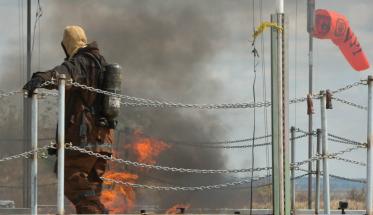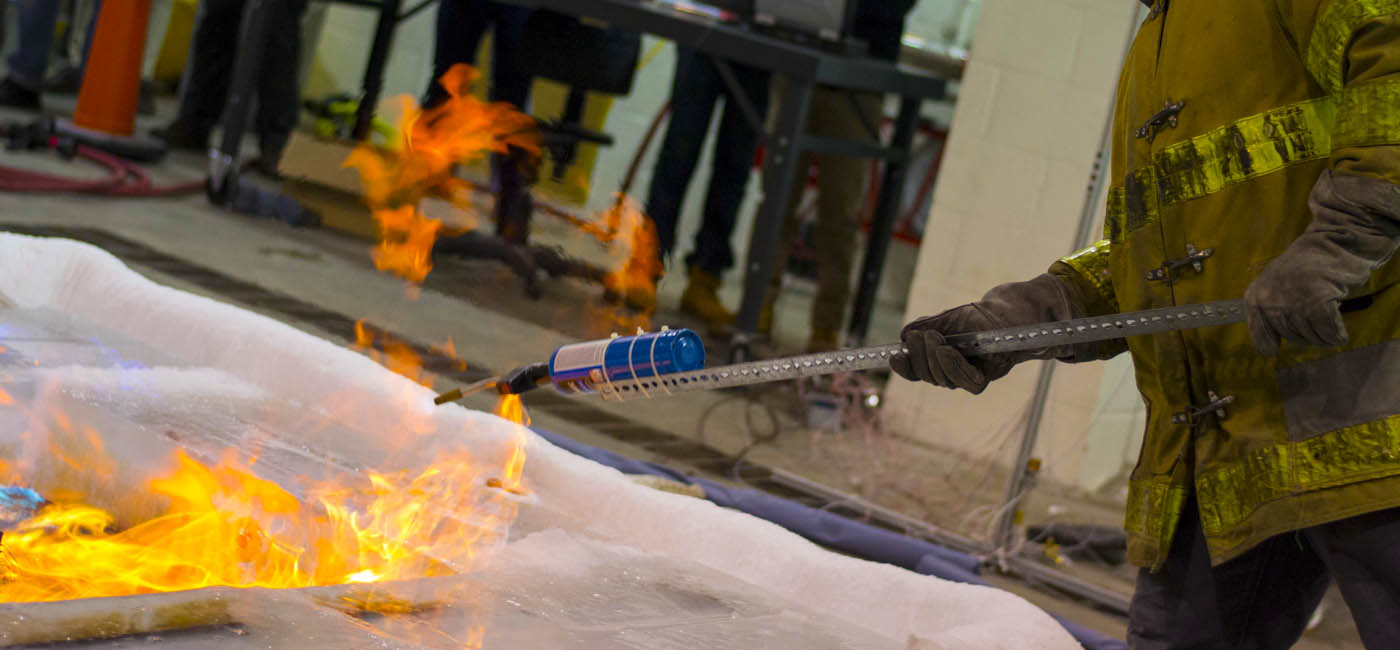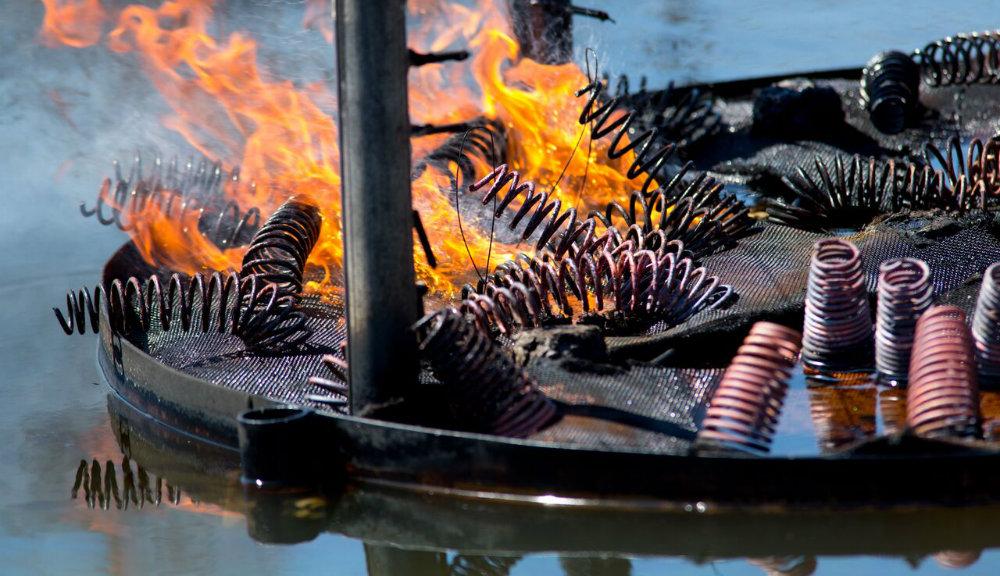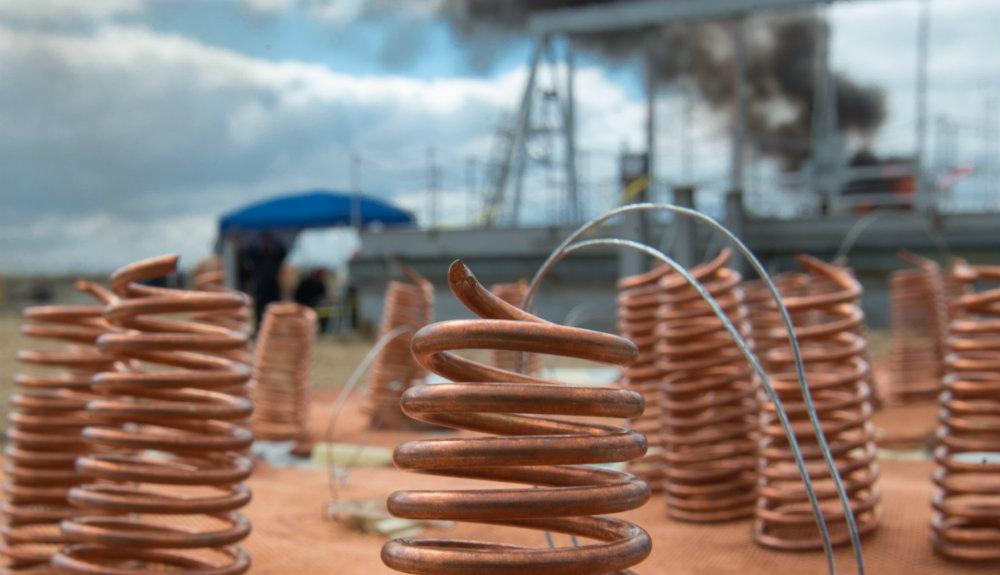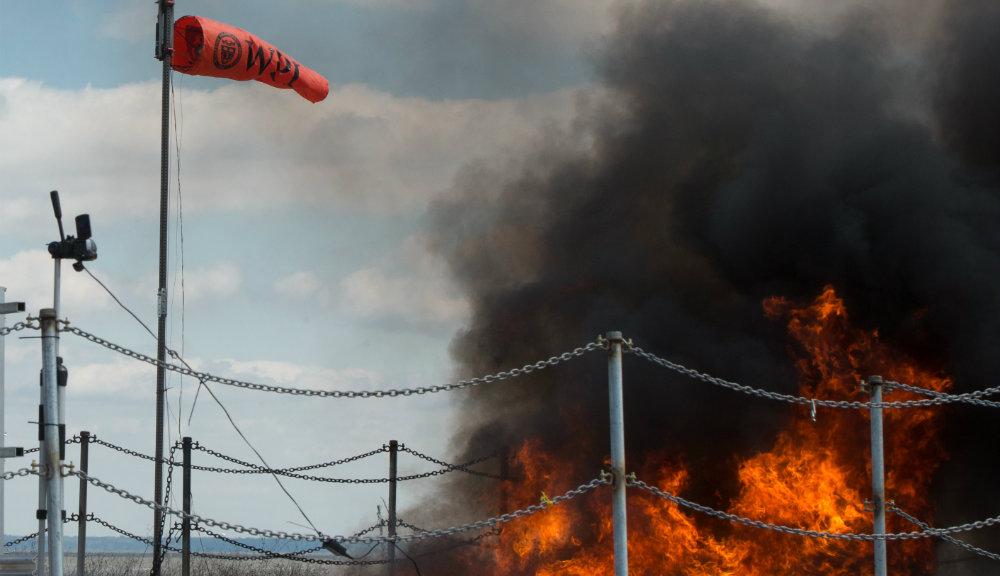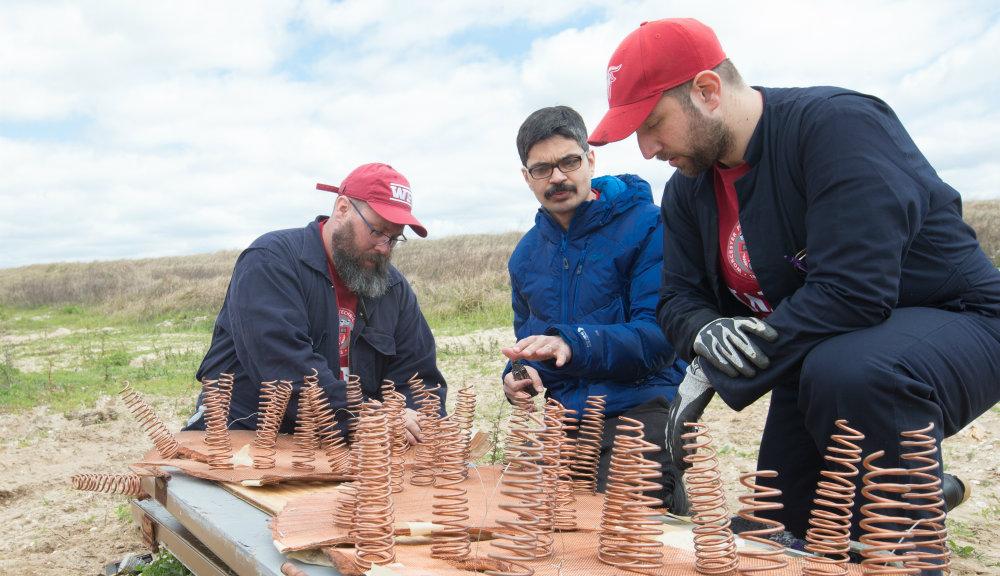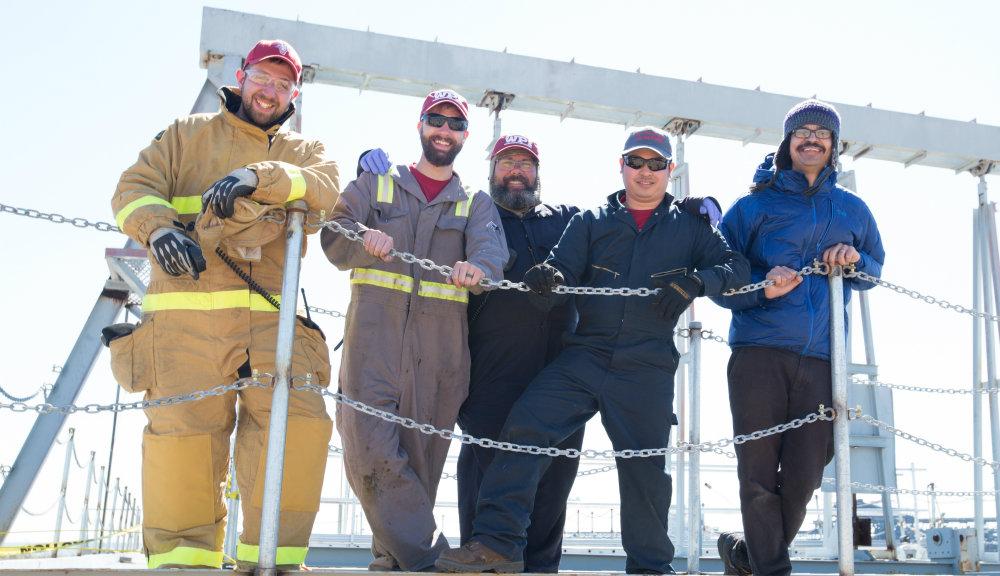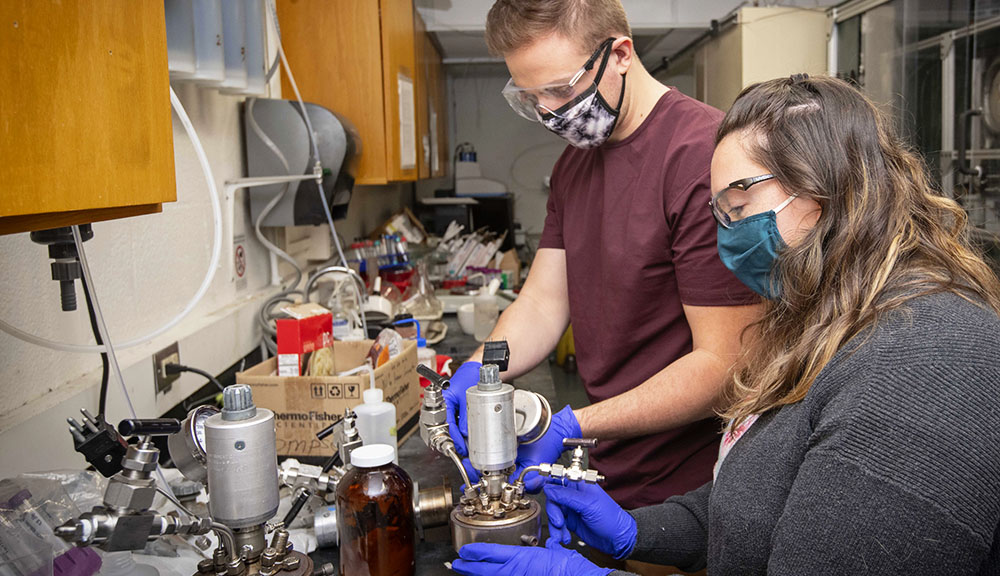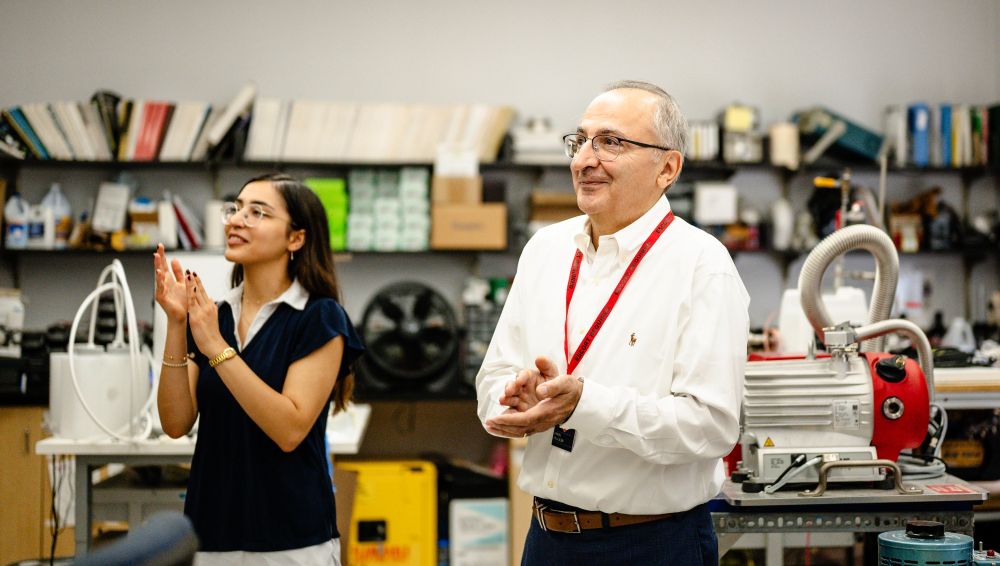A thick overcast masks the sunrise on this unseasonably cold mid-March morning as a crew of WPI researchers and personnel from the U.S. Coast Guard, the U.S. Navy, and the Department of the Interior board a small landing craft at Coast Guard Sector Mobile on the Gulf Coast of Alabama. With a rumble, the craft pulls away from the dock and plows through the muddy waters of Mobile Harbor, shadowed by cormorants, pelicans, and frolicking dolphins. Rounding McDuffie Island, with its massive coal terminal, the craft comes in sight of Little Sand Island, a 49-acre windswept stretch of sand and low vegetation.
The boat beaches beside the ex-USS Shadwell, a retired World War II-era U.S. Navy landing ship dock that, since 1988, has served as a lab for the Fire Research Detachment of the U.S. Naval Research Laboratory (NRL). With the Coast Guard Research and Development Center, the NRL runs the Joint Maritime Test Facility here. While the Navy focuses on preventing and extinguishing fires aboard ships, the Coast Guard’s interest is using fire as a tool to clean up marine oil spills in place—a technique called in situ burning.
That’s what has brought the WPI research team here. For the past three years, under the leadership of Ali Rangwala, professor of fire protection engineering, it has been developing a new technology that could make in situ burns (or ISBs) easier to conduct, more efficient, and cleaner. Simple and inexpensive, the Flame Refluxer could revolutionize how spills are mitigated.
The technology has delivered highly promising results in controlled tests in WPI’s state-of-the-art fire protection engineering laboratories. Today is the first of three days of testing that will reveal how well the device functions under real-world conditions.
Fast and Effective
When crude oils spills in open water, the potential for ecological harm looms—to plants and animals in the water column, and to those on shore, should the oil drift. Traditional clean-up methods, like corralling the oil and skimming it from the surface or breaking it into small globules with chemical dispersants, are often ineffective and they can, themselves, be harmful to marine life. Oil spill experts have long believed that the fastest and most effective way to remove the oil is to light it on fire, transforming the thick, toxic goo into water, CO2 and other gases, and particulate matter. Still, the clean-up method has seen only limited use.
Research on ISBs began in earnest in the early 1970s with groundbreaking laboratory studies aimed at understanding the physical and chemical properties of the emulsions that form when oil mixes with water and the challenges entailed in igniting and sustaining oil fires on water. Tests at the National Oil Spill Response Test Facility in New Jersey in the early 1980s and work by the National Institutes of Standards and Technology (NIST) in the 1990s proved the effectiveness of ISBs, which can remove about 90 percent of spilled oil.
At around the same time, NIST, in partnership with other U.S. and Canadian agencies and oil companies, began an extensive research program on Little Sand Island. Starting in 1998, a new steel burn pan (108 feet long, 38 feet wide, 5 feet deep) hosted a series of large-scale burns that refined the challenges and promises of ISBs and drove the development of fire-resistant booms, which would be necessary to corral and contain the burning oil. The last test was conducted in 2000, and in 2005, the burn pan was seriously damaged by hurricane Katrina.
In the interim, in situ burning would receive its most extensive real-world application to date. On April 20, 2010, a catastrophic explosion on the Deepwater Horizon rig off the coast of Louisiana triggered the largest accidental marine oil spill in history; in all, about 4.9 million barrels of crude leaked into the Gulf over the course of nearly three months.
About 5 percent of that oil was burned in a large-scale operation overseen by an interagency group. More than 400 burns were conducted inside 400-foot-long fire booms towed by small boats. “The burns were quite successful,” says Kurt Hansen, project manager at the U.S. Coast Guard Research and Development Center. “They worked better than expected. The fires were so hot they created updrafts that pulled more oil into the booms.”
That success revived interest in research on ISBs at the Joint Maritime Test Facility. By the fall of 2015, the Coast Guard, the NRL, and Interior Department’s Bureau of Safety and Environmental Enforcement (BSEE) had repaired the burn pan and readied it for a new era of test burns. A year later, WPI would become the first university granted use of the reopened facility.
The Birth of an Idea
Much of the early interest in in situ burning arose from worries about how to clean up oil spills in the Arctic, an inaccessible region covered by ice and snow much of the year. In situ burning seemed the only practical solution. But while the approach made sense, there was no guarantee that oil would burn in extreme cold and while sitting on top of ice and icy water, both excellent heat sinks.
That’s where WPI entered the picture. In 2014 BSEE awarded Rangwala the first of a series of awards that now total more than $1.5 million. The initial grants funded laboratory studies aimed at answering fundamental questions about the combustion of oil in Arctic conditions.
Starting with test burns on disks of ice the size of hockey pucks and moving on to experiments with ice sheets, ice channels, and one-meter-square pools of crude oil surrounded by a field of ice blocks, Rangwala’s team, which included postdoctoral researchers Xiaochuan (Lydia) Shi, made a number of groundbreaking discoveries, including the fact that burning oil sinks into ice, creating widening pockets that thin out the oil, making it more difficult to burn, and which can ultimately trap unburned oil beneath an ice layer.
They also found that ice and frigid water create thermal inertia, making the oil harder to ignite and the fires more difficult to sustain. Rangwala wondered if there might be a way to warm the oil to make it more volatile. Since it’s oil vapors that burn, not the oil itself, getting the oil to vaporize more readily should enhance ignition and burning, he reasoned. “Typically, with in situ burns, about 95 percent of the heat goes up into the atmosphere by buoyancy,” he says. “I knew that if we could transfer some of that heat to the fuel we could create a feedback loop, enhancing the burning rate, creating still more heat, to enhance the burning rate further, and so on.”
Rangwala started experimenting with the use of metal rods to conduct heat into the oil. From that brainstorm was born the Flame Refluxer. Practical experiments with the rods and a computational model of the effects of immersed metal objects developed by postdoctoral researcher Hayri Sezer showed that the idea had great promise. The rods acted as both collectors, absorbing heat from the flames, and heaters, promoting vaporization of the oil. The next step was to more effectively spread the refluxed heat through the oil. That led to replacing the heater portion of the rod with the blanket. The final innovation was transforming the simple rods into metal coils to increase their surface area and their contact with the flames.
Tests of prototypes of various sizes and with varying numbers and configurations of coils helped refine the design and provided insights into how it would behave at the large scale (up to 60 feet across) that would likely be required for real-world applications. The next step, funded by a $1 million award from BSEE, was to take the Flame Refluxer outside and see how it performed when subjected to the whims of wind and weather.
“We receive a lot of proposals for technology to improve in situ burning,” says Karen Stone, oil spill response engineer at BSEE. “This one really got our attention, because of WPI’s proven expertise with combustion and because they were able to offer us something that went beyond a good idea. They had the data and they understood the science.”
Making a Difference
The WPI research team fans out to make preparations for the week’s first burn. The equipment and instruments for the test are already in place, having been set up the week before by a crew headed by Trevor Borth, manager of Rangwala’s Combustion Laboratory. The centerpiece is a test stand consisting of a metal ring 1.4 meters across, resting on four legs just over a meter tall; the stand will support the blanket at the surface of the water inside the burn pan.
Tubes projecting up from each leg and one in the middle of the stand hold dozens of thermocouples that will measure the temperature of the flames. Other instruments will monitor heat flux, and an innovative system designed by FPE master’s candidate Panyawat “Oat” Tukaew will collect and analyze emissions. The system consists of a windsock that funnels gases through instruments that measure their volume and temperature and feeds them to an analyzer that records levels of oxygen, carbon dioxide, carbon monoxide, nitrous oxide, nitrogen dioxide, and sulfur dioxide.
A network of pipes delivers oil to outlets beneath the blanket, while a camera below the waterline helps the researchers keep the oil layer at about one centimeter (previous work showed that ISBs work best when the oil layer is maintained at between 1 and 4 centimeters). Before each burn, members of the Coast Guard’s Gulf Strike Team position portable air monitoring devices around the burn pan to measure particulate matter, the pollutant that presents the greatest health risk to personnel who need to be in close proximity to open-water oil burns.
Before the week is out, six burns will be completed, overseen by Rangwala and postdoctoral researcher Kemal Arsava. They will include a test with the blanket alone (no coils) and three tests with various coil configurations. Lab tests showed that with two rings of coils, the outer ring does the lion’s share of absorbing heat, probably because it receives more oxygen and because convection currents near the center of the blanket create soot that interferes with heat transfer to the coils there.
This week, a test with just the outer coils and one with longer coils in the center will help fine-tune the configuration to maximize heat transfer to the oil. In future research, the WPI team plans to inject air at the center of the blanket to see if pre-mixing the oil vapors with air will reduce soot formation.
The two burns planned for Day 1 will serve to dramatically demonstrate the beneficial effects of the Flame Refluxer. The first is a baseline test—a 10-minute burn without the Refluxer. For the second, the blanket with two rings of 20-centimeter coils is placed in the ring. Even without glancing at the stream of data flowing into the control shed, it is clear that the Refluxer has made a difference.
In contrast to the thick black smoke that billows from the baseline burn, the smoke from the Refluxer test is thin and gray, and it dissipates quickly. When the fuel flow is shut off, the baseline fire burns on for another five minutes, but leaves a layer of unburned oil that Arsava and David Petrow, a lab assistant in FPE and the fifth member of the WPI team, must laboriously sop up with absorbent pads so it can be weighed. It takes more than an hour for the last flames to die out after the Refluxer burn, and when the blanket is lifted up, the water looks clean. Even the tarlike residue normally produced by ISBs (which can harm marine life as it sinks into water column) appears to have been burned off.
“After the baseline burn, we collected 20 kilograms [about 44 pounds] of unburned oil,” Arsava says. “One of the advantages of the Flame Refluxer blanket is that it can collect that residue. In our test burns, the blanket collected about six kilograms [13 pounds] of residue, and only one kilogram [2.2 pounds] was left in the water.”
By week’s end, the research team is all smiles. In the real-world laboratory on Little Sand Island, the Flame Refluxer has been a resounding success. On average, Rangwala and Arsava note, the fuel temperature with the Refluxer was 140 degrees C higher than in the baseline fire. In addition, the fire consumed four to five times more oil per minute than the baseline burn, and oil burned more completely, producing 50 percent fewer emissions.
“We have high hopes for this technology, which can make a good technique even better,” says Stone as the testing wraps up. “There is more work to be done, particularly in thinking about how the technology can be deployed in practice, but we are very pleased with what we’ve seen this week.”
Keeping Focused
Back in Worcester, the WPI team unpacks and thinks about where the research may go next. Rangwala is interested in finding ways to further refine and optimize the Refluxer. Studies in the lab showed that it can increase burning rates up to 10 times; he believes it may be possible to get closer to that number in the field. In the meantime, BSEE has invited Rangwala and his colleagues to submit proposals for three new research projects that will expand on the Flame Refluxer work.
Rangwala says this new research will be motivated by the same goal that has driven his team for the past three years. “The longer you let oil linger in the environment, the greater the danger becomes,” he says. “That’s what our work on ISBs is aimed at: reducing the clean-up time to a minimum, and removing the maximum amount of oil from the environment. With each advance, we get closer to those objectives.”
